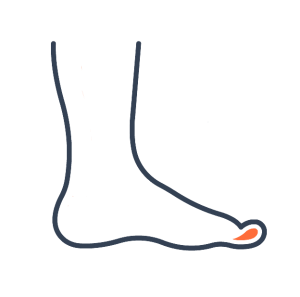A Morton’s Neuroma is a common forefoot condition where the nerve sheath to the toes becomes irritated, inflamed, and forms a thickened scar tissue. It occurs due to repetitive compression upon the common plantar digital nerve most frequently between the 3rd and 4th toes (about 65% of cases) but can occur between the other metatarsals.

Morton’s Neuroma Symptoms
You might experience any of the following:
- a bruised feeling
- shooting pains
- clicking sensation
- pins and needles or numbness as a result of the nerve being affected
A Morton’s Neuroma is usually most painful at the toe-off stage of gait.
What Causes Morton’s Neuroma?
Perineural Fibrosis or thickening of the nerve sheath is usually due to chronic trauma in the form of long term overload of the tissue structure. The body lays down collagen fibres or scar tissue to try to protect the overloaded structure.
Your foot biomechanics can predispose you to neuroma development. Poor foot arch control leading to flat feet or foot overpronation causes mobility in the metatarsals, rubbing the nerve. High arch feet tend to put more pressure on the ball of the foot, and this can cause trauma, too.
Tight-fitting shoes may exacerbate a Morton’s Neuroma. Even worse is if the shoe has a heel and allows the forefoot to slide into the narrow toe-box (e.g. women’s fashion shoes and cowboy boots). These shoes have a sloping footbed and a narrow toe box. Also, ‘flatties’ (flat shoes) can be painful due to the lack of shock-absorption in the forefoot.
Morton’s Neuroma Treatment
The first step is always to obtain some pain relief, minimise swelling & reduce the chance of further damage.
Pain and discomfort may benefit from analgesia and anti-inflammatories and ice therapy. Devices such as padding or strapping, metatarsal domes or orthoses can offload pressure and friction from the nerve.
One of the biggest factors in relieving pain may be changing or modifying your footwear. This may mean different shoes or looking at avoiding tight fitting heels or shoes.
Sometimes a corticosteroid injection or chemical/alcohol ablation is required to help settle the inflammation surrounding the nerve. These treatments are performed under local anaesthetic at a radiology clinic. You should experience good pain relief with these methodologies; however, they are reserved for when other methods haven’t been successful. If everything else has failed, surgery is still an option.
